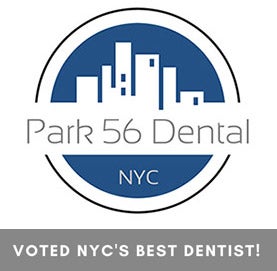-
The Benefits of Sedation Dentistry
 The best dentist in NYC relies on sedation dentistry near NYC to help patients ease anxiety. Sedation dentistry is recommended for many procedures at the dentist office, including dental cleaning, root canal, and smile restoration.
The best dentist in NYC relies on sedation dentistry near NYC to help patients ease anxiety. Sedation dentistry is recommended for many procedures at the dentist office, including dental cleaning, root canal, and smile restoration. The top dentist in New York offers sedation dentistry to help patients relax during simple and complex dental procedures. A sedation dentist can ensure that you experience no pain or discomfort during your dental work—and do not even remember the procedure afterwards. When you visit the best dentist in NYC, your dentist can perform any procedure safely and pain-free. Patients will have no sense of time, smell, or sound.
Park 56 Dental is pleased to offer all our New York area clients the very latest in sedation dentistry . Never let your anxiety about visiting a dentist get in the way of your oral health. Call us at (646) 783-3529 for an appointment with a sedation dentist near NYC.
-
What Are Dental Crowns and Bridges?
A top dentist in NYC regularly recommends dental crowns and dental bridges for clients in need of dental clinic treatment. Both crowns and bridges are permanent solutions. The best dentist might recommend a crown to fix a damaged or weakened tooth, while bridges are suggested for patients with missing teeth. Both crowns and bridges improve upon the smile’s aesthetic appearance and overall dental health. Read on to find out how crowns and bridges are made, how they work, and how long they can be expected to last.
Smile Reparation

Crowns entirely cover or “cap” damaged teeth. They also improve the appearance, shape, and alignment of teeth. A crown can be placed on top of a dental implant to create a natural-looking prosthetic tooth. Bridges, on the other hand, are recommended to fill spaces where one or more than one tooth is missing. Bridges are cemented to a natural tooth or tooth implant.
Customized Process
For crowns and bridges to be placed, a dentist first reduces the size of the natural teeth to make room for the prosthetic. Next, your dentist will take an impression of your teeth to create an exact mold for the crown or dental bridge. A dental lab creates the prosthetic teeth in porcelain, ceramic, or metal, depending on your needs and oral health.
Permanent Solution
Crowns and dental bridges are both permanent solutions and can only be removed by visiting a dentist office. While crowns and bridges can last a lifetime, they require proper care. To prevent damage to a crown, bridge, or tooth implant, avoid chewing hard foods or ice. You should also practice good oral hygiene and visit your dentist for regular teeth cleanings to avoid dental disease.
If you need dental crowns, dental bridges, or veneers, you deserve to be treated by the best dentist in NYC. At Park 56 Dental , our dentist office exceeds all expectations. For the top dentist in NYC, call our office at (646) 783-3529. You can also visit us online to find out more about our general dentistry services.
-
How to Handle Dental Emergencies [INFOGRAPHIC]
Everyone wants to have a beautiful smile full of healthy teeth. Even if you brush, floss, and visit a dental clinic near New York City regularly, dental emergencies can happen at any moment. That’s why it’s a good idea to know what to do in the event of a dental emergency. If you have a toothache, rinse your mouth out with warm water and try to dislodge anything stuck between your teeth with dental floss. Never apply aspirin or other painkillers directly to the painful area, as this could burn sensitive tissue. A knocked-out tooth should be handled by the crown, rinsed off, and replaced in its socket if possible; when you see your dentist within an hour of the tooth being knocked out, your chances of saving the tooth are much higher. Take a look at this infographic from Park 56 Dental to learn more about handling common dental emergencies. Please share with your friends and family.

RECENT POSTS
categories
- Uncategorized
- Cosmetic Dentistry
- Veneers
- Healthier Teeth
- Teeth Whitening
- Dental Health
- Video
- Dental Emergencies
- Invisalign
- Dental Implants
- Root Canal
- Sedation Dentistry
- Infographic
- Dental Crowns and Bridges
- Dental Anxiety
- Gum Disease
- COVID-19
- Bad Breath
- New York Dentist
- Cut out sugar
- General Dentistry
- Oral Health
- Oral Cancer
- Dry Mouth
- Gum Health
- Toothache
- Dental Sealants
- Cavities
